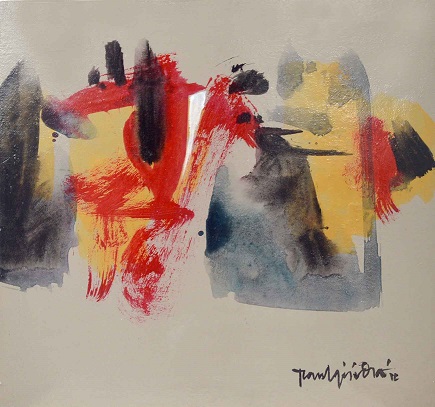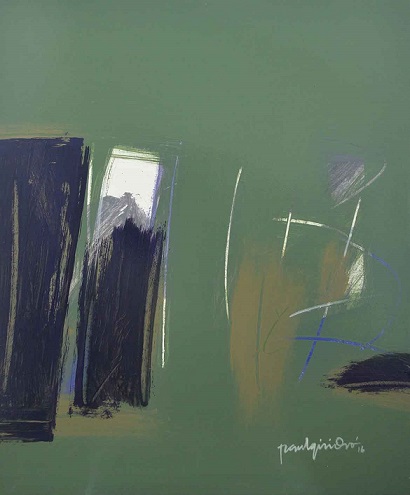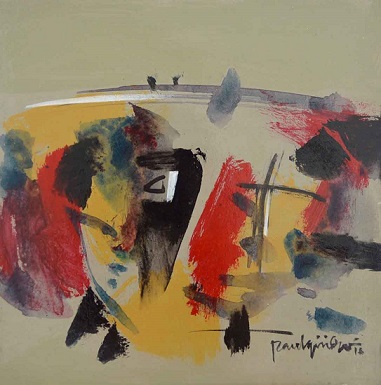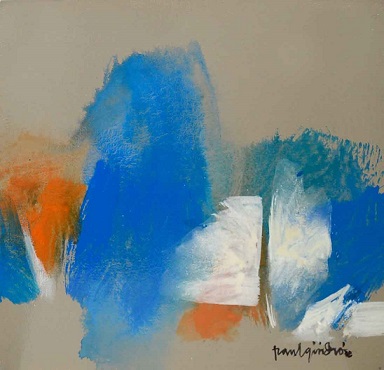
By WINNIE VELASQUEZ
“EVERYDAY is a painting day for me,” said Raul Isidro a few hours before his nth exhibit opened March 16 at Galleria Nicolas in Glorietta 4, Makati.
Now well into his seventh decade and with almost fifty years of work as a professional artist (his, first solo exhibit was in 1969) the quintessential abstractionist this time presents viewers and collectors with small and medium-sized canvases pulsating with colors that seemingly leap out of their frames; craggy rock formations, parched earth, grey and black vistas. All these elements, Isidro orchestrates into a seamless collection held together by his deft handling of light and shadows. (The exhibit may be viewed until March 31).
“My works are actually landscapes. They are abstractions, “ he said.
“But,” he stressed, “ but they are also depictions of the organic forms of nature, its colors and shapes, the present condition of our environment; climate change and all its harsh effects on our lives today.”

The grim subject of his works notwithstanding, the canvases on exhibit are neither an indictment of current practices and policies that affect our world nor are they a crusader’s loud plea for the environment. Instead, their subjects depict the terrain we live in today and are depictions of the landscapes in the mind’s eye of an artist highly skilled in the genre he has embraced while continuously experimenting with forms to give viewers of his abstract paintings something new with every exhibit.
“To appreciate a work of art, you first look at it up close… then move back, view it from a distance. The elements of the painting come into your line of sight and you filter it through your mind’s eye. That is why no two persons react to an artwork in the same manner. You relate to a painting or sculpture on a very personal level. You also see it based on the kind of exposure you’ve had,” Isidro said.
Interestingly, he cited the aerial view of a landscape: “For example, you are on an airplane and look through the window as it descends just before sunset… the movement of water from that distance, the shapes and colors of the land, the vegetation or lack of it, take on forms and shapes that are akin to an abstract piece you would see on a gallery wall,” he added.

Isidro, who served for several decades as professor and dean of the College of Fine Arts at the Philippine Women’s University, cited the above examples as a guide for the appreciation not only of his works but of abstract art in general. Abstract works, he said, must have a basis in real objects and forms and not mere splashes of colors thrown randomly across a blank canvas or lines and squibbles whimsically drawn.
Asked what inspires him to paint, Isidro said he always goes back to the source of his art. “What inspires me, the forms I render on my canvases, these all come from my provincial beginnings. Growing up in Catbalogan, Samar, verdant fields, the golden glow of light at sunrise, blue clouds gradually turning a darker hue behind a blazing but dying sun and the darkness of night — all these are the elements you can glean in my works,” he said.
And the move in the direction of abstraction was a gradual transition that started – as with most professional artists – with figurative works then impressionist paintings and evolved in the Sixties from the firm decision to embrace abstraction. “Abstract art was not yet very popular then but I felt that it was the direction I wanted to take. It was a logical transition as I couldn’t see myself painting more pastoral scenes, one more bahay kubo,” he said with that trademark glint in his eyes. “But this is not to say that landscapes with these familiar scenes are not great works of art,” he quickly clarified.

The next decade – the Seventies – validated Isidro’s decision. “There was then a growing acceptance of abstract forms of expression, not just in painting but even in sculpture and all the other arts. I used to do sculpture too but I decided to focus on my painting and I haven’t looked back since,” he said.
This means for this most prolific artist maintaining a daily routine that would faze painters half his age. Until he had an eye operation a few years ago, Isidro took up his brush every day in his studio on the upper floor of his airy home that gives him a view of Laguna de Bay on a clear day. “I used to paint for eight to 12 hours and never tired of it but I’ve slowed down a bit of late. I am growing older,” he said but added quickly, “I still paint almost every day, but for shorter periods now.”
What can viewers and collectors of Raul Isidro’s art expect from him then in his next exhibit? (One doesn’t ask him about the next few years because he has never lacked new works to mount an exhibit at least twice a year.) “They will see bolder strokes, freer forms and I will again be exhibiting larger pieces. I like to do this because it allows for more freedom of movement. Large or small, the same effort goes into a painting, working time is similar, too but the satisfaction I get when I finish a huge canvas is something else,” the master said with a soft chuckle and that glint in his eyes.

